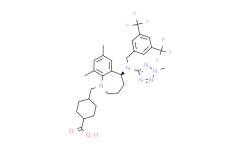| Cas No.: | 1186486-62-3 |
| Chemical Name: | Evacetrapib |
| Synonyms: | (1S,4r)-4-(((S)-5-((3,5-bis(trifluoromethyl)benzyl)(2-methyl-2H-tetrazol-5-yl)amino)-7,9-dimethyl-2,3,4,5-tetrahydro-1H-benzo[b]azepin-1-yl)methyl)cyclohexanecarboxylic acid;Evacetrapib (LY2484595);(1S,4r)-4-(((S)-5-((3,5-bis(trifluoromethyl)benzyl)(2-methyl-2H-tetrazol-5-yl)amino)-7,9-dimet...;(1S,4r)-4-(((S)-5-((3,5-bis(trifluoromethyl)benzyl)(2-methyl-2H-tetrazol-5-yl)amino)-7,9-dimethyl-2,3,4,5-tetrahydro-1H-benzo;(1S,4r)-4-(((S)-5-((3,5-Bis(trifluoromethyl)benzyl)(2-methyl-2H-tetrazol-5-yl)amino)-7,9-dimethyl-2,3,4,5-tetrahydro-1H-benzo[b]azepin-1-yl)methyl)cyclohexanec;4-[[(5S)-5-[[3,5-bis(trifluoromethyl)phenyl]methyl-(2-methyltetrazol-5-yl)amino]-7,9-dimethyl-2,3,4,5-tetrahydro-1-benzazepin-1-yl]methyl]cyclohexane-1-carboxylic acid;Evacetrapib;Evacetrapib(LY-2484595, LY2484595);LY2484595;LY-2484595;trans-4-[[(5S)-5-[[[3,5-Bis(trifluoromethyl)phenyl]methyl](2-methyl-2H-tetrazol-5-yl)amino]-2,3,4,5-tetrahydro-7,9-dimethyl-1H-1-benzazepin-1-yl]methyl]cyclohexanecarboxylic acid;LY 2484595;51XWV9K850;Evacetrapib [USAN:INN];AK172427;Evacetrapib (USAN);Tube726;GTPL8401;C31H36F6N6O2;IHIUGIVXARLYHP-YBXDKENTSA-N;HMS3651J12 |
| SMILES: | FC(C1C([H])=C(C(F)(F)F)C([H])=C(C=1[H])C([H])([H])N(C1N=NN(C([H])([H])[H])N=1)[C@]1([H])C2=C([H])C(C([H])([H])[H])=C([H])C(C([H])([H])[H])=C2N(C([H])([H])C([H])([H])C1([H])[H])C([H])([H])C1([H])C([H])([H])C([H])([H])C([H])(C(=O)O[H])C([H])([H])C1([H])[H])(F)F |
| Formula: | C31H36F6N6O2 |
| M.Wt: | 638.65 |
| Purity: | >98% |
| Sotrage: | 2 years -20°C Powder, 2 weeks 4°C in DMSO, 6 months -80°C in DMSO |
| Description: | Evacetrapib is a potent and selective of CETP inhibitor, which inhibits human recombinant CETP protein (IC50 5.5 nM) and CETP activity in human plasma (IC50 36 nM) in vitro. |
| Target: | IC50: 5.5 nM (CETP)[1] |
| In Vivo: | In double transgenic mice expressing human CETP and apoAI, Evacetrapib exhibits an ex vivo CETP inhibition ED50 of less than 5 mg/kg at 8 h post oral dose and significantly elevated HDL cholesterol. Importantly, no blood pressure elevation is observed in rats dosed with Evacetrapib at high exposure multiples compared with the positive control, torcetrapib. Evacetrapib administered orally at 30 mg/kg results in 98.4%, 98.6%, and 18.4% inhibition of CETP activity at 4, 8 and 24 h post dose respectively. Evacetrapib dosed orally at 30 mg/kg resulted in 129.7% increase in HDL-C 8 h after oral administration[1]. |
| In Vitro: | Evacetrapib is a novel benzazepine-based CETP inhibitor. In the buffer CETP assay, the absolute potency of the compound is 5.5 nM. In the human plasma CETP assay, the CETP concentration is about 2 μg/mL (25 nM) and the 36 nM IC50 value again indicates that Evacetrapib is a potent CETP inhibitor against either the recombinant protein or CETP from human plasma. Evacetrapib is apparently much more potent than Dalcetrapib[1]. |
| Kinase Assay: | Human CETP cDNA is amplified from a human liver cDNA library and the sequence is confirmed to be identical to the published sequence. The cDNA is subcloned into a pcDNA3.1 vector, under the control of CMV promoter. A stable line is established in CV1 cells in which the above-mentioned construct is used to express the recombinant human CETP. The medium contained the secreted recombinant CETP protein and the amount (19 ng/μL) is quantified by an ELISA kit. The medium is then aliquoted in 0.2% BSA and stored at -80°C. The stock CETP protein is diluted 150-fold in CETP buffer (10 mM Tris, 150 mM NaCl, and 2 mM EDTA) before use. The assay is set up in a 96-well plate. Each well received 97.5 μL diluted CETP protein (final concentration 7 nM) and 2.5 μL of compound stock. After a 30 min incubation at 37°C, 5 μL of substrate stock (the same stock used in the human plasma CETP assay), 0.16 μL of VLDL stock (2.5 mg/mL, Intracel) and 145 μL of CETP buffer are added, and the incubation is continued for another 4 h. Signal is read for the human plasma CETP assay[1]. |
| Animal Administration: | Rats[1] The blood pressure study is carried out using telemetered, male, obese Zucker Diabetic rats (ZDF fa/fa rats, 8 weeks of age on arrival; n=4). All rats underwent surgical implantation of a telemetry transmitter for continuous monitoring of hemodynamic parameters throughout the study. The rats are acclimated on Purina 5008 chow and house water ad libitum until 11 weeks of age. Mean daily blood pressure for the 24-h period immediately prior to administration of compound is taken as the baseline blood pressure. On the day of an experiment, a single 160 mg/kg dose (in 10% acacia) of Evacetrapib as the lysine salt is administered by oral gavage, and the drug effect is taken as the average daily mean arterial pressure (MAP) during the 24 h period following the dose. Data are expressed as the change in MAP from baseline. Following the last day of blood pressure monitoring, samples are collected from the orbital sinus at 1, 2, 4, 8, and 24 h post dose into tubes containing EDTA and processed into plasma. Plasma concentrations of Evacetrapib are measured using liquid chromatography tandem mass spectrometry. |
| References: | [1]. Cao G, et al. Evacetrapib is a novel, potent, and selective inhibitor of cholesteryl ester transfer protein that elevates HDL cholesterol without inducing aldosterone or increasing blood pressure. J Lipid Res. 2011 Dec;52(12):2169-76. |






















